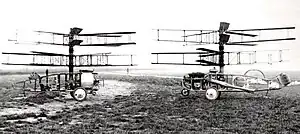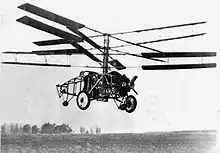Pescara Model 3 Helicopter
The Pescara Model 3 was the first of several coaxial helicopter designs by Raúl Pateras Pescara to demonstrate sustained controlled helicopter flight.
| Model 3 | |
|---|---|
 | |
| Model 2 and Model 3 | |
| Role | Helicopter |
| National origin | France |
| Designer | Raúl Pateras Pescara |
| Introduction | 1923 |
| Number built | 1 |
Development
Argentinian engineer Pescara started helicopter development in 1916. Alberto Santos-Dumont helped fund experimentation on designs in France. Multiple examples were built, demonstrated, crashed, improved and rebuilt owing to conflicting and different names for the various versions.[1] Anticipating success with the counter-rotating mechanism, Pescara patented a design with a streamlined fuselage with one set of rotors above, and one below the fuselage.[2]
The model three was the first example to use control mechanisms as modern helicopters. The helicopter is based around a central shaft with counter-rotating rotors. Each rotor was doubled into a biplane arrangement with cable supports.[3] It used a cyclic stick for forward and lateral control with rotor warping, and wheel for yaw anti-torque control.[4] The main rotor shaft was able to tilt slightly for forward control.[5] The rotors were also capable of autorotation in case of engine failure.[6]
Operational history
In September 1923, a 1 km flight attempt was nearly completed, before the vehicle crashed. On 24 May 1924 Étienne Oehmichen set a world helicopter record flight of 358m. On 18 April 1924 the model 2F bested the record and flew 736m at 8 mph to set a record in sustained vertical flight.[7]
Variants
- Pescara Model 1
- 1919 - 45 hp (34 kW) Hispano automobile engine, later 170 hp (130 kW) Le Rhône Type 9R rotary
- Pescara Model 2
- 45 hp (34 kW) Hispano automobile engine, Six pairs of Biplane blades
- Pescara Model 2F
- Rear mounted radiator replaced with tail surface.
- Pescara Model 3
- Four pair of conter-rotating biplane blades - 180 hp (130 kW) Hispano-Suiza 8

- Pescara Model 4S
- 1931-Final British commissioned model featuring a radial engine with a small cooling propeller, and football shaped landing outriggers.[8]
Specifications (Model 3)
Data from Air Progress
General characteristics
- Crew: 1
- Powerplant: 1 × Hispano-Suiza 8 V-8 piston engine, 130 kW (180 hp)
- Main rotor diameter: 16 × 7.2 m (23 ft 7 in)
Performance
- Maximum speed: 13 km/h (8.0 mph, 7.0 kn)
- Range: 0.736 km (0.457 mi, 0.397 nmi) Demonstrated range
See also
Aircraft of comparable role, configuration, and era
References
- James R. Chiles. The God Machine: From Boomerangs to Black Hawks: The Story of the Helicopter. p. 70.
- "Patent US1527701A". Retrieved 21 October 2013.
- J. Gordon Leishman. Principles of Helicopter Aerodynamics. p. 17.
- Wayne Johnson. Helicopter Theory. p. 14.
- Florian Ion Petrescu, Relly Victoria Petrescu. The Aviation History. p. 73.
- Stanley S. McGowen. Helicopters: An Illustrated History of Their Impact. p. 6.
- Air Progress: 56. December 1971.
{{cite journal}}: Missing or empty|title=(help) - "New Helicopter Rises in Vertical Flight". Popular Science: 70. March 1931.